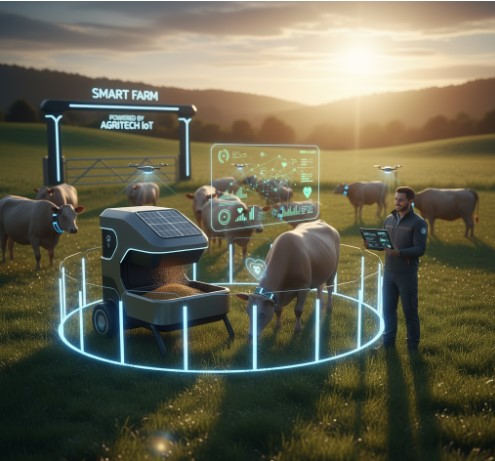The Future is Fenced: Smart Farming Tech Transforming Livestock Management
In an ever-evolving world, agriculture stands at the forefront of innovation. Gone are the days when livestock management relied solely on intuition and manual labor. Today, a quiet revolution is underway in fields and barns worldwide, driven by cutting-edge smart livestock farming technologies. This shift towards precision livestock farming is not just about adopting new gadgets; it's about fundamentally transforming how farmers interact with their animals, optimize resources, and secure a sustainable future. Let's dive into the exciting advancements that are reshaping the landscape of animal agriculture. The Rise of Connected Herds: IoT in Agriculture At the heart of livestock technology is the Internet of Things (IoT). Imagine a farm where every animal is a data point, constantly providing insights into its well-being and productivity. This is no longer a futuristic dream but a present-day reality thanks to tiny, robust sensors and interconnected networks. Animal monitoring systems, powered by IoT, offer an unprecedented level of oversight. These systems often involve: Wearable Sensors: Attached to collars or ears, these sensors track vital signs like body temperature, heart rate, and activity levels. They can detect early signs of illness, stress, or even estrus cycles, allowing farmers to intervene proactively. This leads to healthier animals and more efficient breeding programs. Ingestible Sensors: For a more internal look, some innovations include ingestible sensors that monitor rumination, pH levels, and overall digestive health. This data is critical for optimizing feed regimens and preventing metabolic disorders. Environmental Sensors: Beyond the animals themselves, IoT sensors monitor conditions within barns and pastures – temperature, humidity, air quality, and even soil moisture. Maintaining optimal environmental conditions directly contributes to animal comfort and health. Smarter Feeding, Happier Animals: Automated Feeders One of the most labor-intensive aspects of livestock farming is feeding. Farm automation has introduced sophisticated automated feeding systems that promise efficiency and precision. Individualized Nutrition: These systems can dispense precise amounts of feed tailored to each animal's specific needs, age, and production stage. This not only reduces feed waste but also ensures optimal nutrition, leading to better growth rates and milk production. Reduced Human Error: Automation minimizes the chances of over or underfeeding, ensuring consistency and reliability. Time Savings: Farmers can redirect valuable time previously spent on manual feeding to other critical tasks, improving overall farm management. Know Where They Roam: GPS Tracking and Virtual Fencing Managing large herds across vast pastures presents unique challenges, especially concerning grazing patterns and security. Agritech innovations like GPS tracking and virtual fencing are providing elegant solutions. GPS Tracking: Collars equipped with GPS allow farmers to monitor the precise location of their livestock in real-time. This is invaluable for locating lost animals, monitoring grazing habits, and understanding herd dynamics. Virtual Fencing: This groundbreaking technology uses GPS and trained behavioral responses (e.g., audio cues, mild electrical pulses) to keep animals within designated grazing areas without physical fences. It allows farmers to create flexible grazing rotations, preventing overgrazing and promoting pasture health, all while reducing the labor and material costs associated with traditional fencing. The Power of Information: Data Analytics All these sensors and automated systems generate a colossal amount of data. The true power of smart livestock farming lies in how this data is collected, analyzed, and translated into actionable insights. Predictive Analytics: By analyzing patterns in animal health, behavior, and production data, farmers can predict potential issues before they become critical. For instance, a slight change in activity might predict lameness, or a drop in rumination could signal a digestive problem. Optimized Decision-Making: Data analytics provides farmers with a comprehensive overview of their operation. This allows for informed decisions regarding breeding schedules, feeding strategies, medication protocols, and market timing, ultimately boosting profitability. Performance Benchmarking: Farmers can compare their herd's performance against industry benchmarks, identifying areas for improvement and optimizing practices. The Benefits Beyond the Bottom Line While increased efficiency and profitability are significant drivers for adopting livestock technology, the advantages extend far beyond financial gains. Improved Animal Welfare: Constant animal monitoring allows for early detection of health issues, leading to quicker treatment and reduced suffering. Animals can also experience less stress due to optimized environments and precise nutrition. Sustainable Practices: Precision livestock farming can lead to more efficient resource utilization, reducing feed waste, water consumption, and even greenhouse gas emissions per unit of production. Virtual fencing, for example, allows for better pasture management, promoting biodiversity. Reduced Labor Demands: Farm automation frees up farmers from repetitive tasks, allowing them to focus on strategic planning and animal care that requires human judgment. The Road Ahead The integration of agritech and IoT in agriculture is not merely a trend; it's the inevitable evolution of livestock management. As these technologies become more affordable and sophisticated, their adoption will only accelerate. The future of farming promises herds that are healthier, happier, and more productive, all thanks to the intelligent application of technology. For modern farmers, embracing these innovations isn't just about keeping up; it's about leading the way to a more efficient, ethical, and sustainable agricultural future. The future is indeed fenced, but these fences are virtual, intelligent, and paving the way for unprecedented advancements in how we care for our livestock.
Mr.Diyan Ahmed


Innovative business solutions.
Connect
Partnering for innovation across industries.
Explore
Discover
+923001534092
© 2025. All rights reserved.
